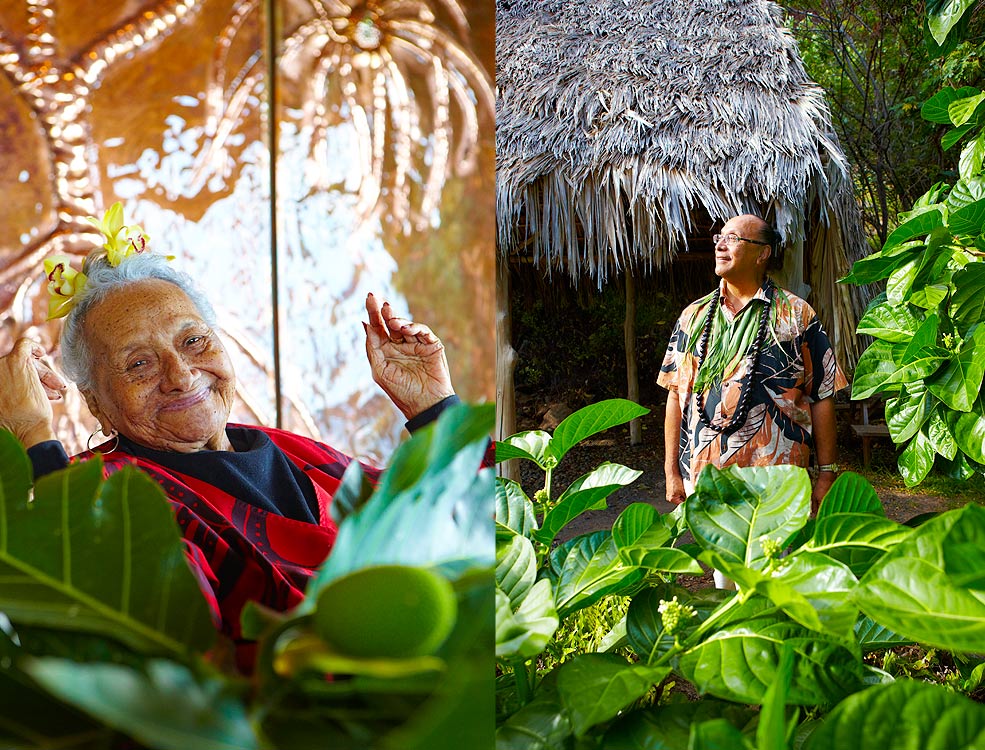By Lianne Bidal Thompson
As you head deeper west along the Waiʻanae Coast, Pu‘u Māili‘ili rises, golden in the sunlight.
This mountain sits squarely in the legendary home of the demigod Maui, and it seems to draw you toward it. Fittingly, the Waiʻanae Coast Comprehensive Health Center (WCCHC) rests at the foot of Pu‘u Māili‘ili, and nestled—almost hugging the mountainside—is the Dr. Agnes Kalaniho‘okaha Cope Traditional Hawaiian Healing Center. As you walk around its grounds, one can literally feel the mana, or power, of the area. Director Kamaki Kanahele (son of the center’s namesake, whom he refers to a “mama,” and everyone else reverently calls “Aunty Aggie”) says “traditional healing is the foundation of all healing,” for the Hawaiian culture.
However, the strength of this place is girded by the strength of the people within, and the healing center is equipped with individuals of formidable talents and skills. The kupuna here, quiet in their nature and intent on their purpose, serve people who come for healing but also work to share and preserve a knowledge that was almost lost to the ages. Kanahele explains that King Kalakaua, during his efforts to revive traditional Hawaiian culture, not only brought back hula and mele, but he also worked to restore traditional healing practices.
“He was the first king to say ‘there will be a society of healers,’ and he actually certified them with his own signature as great healing masters,” Kanahele adds. However, after the fall of the monarchy, practices such as lomi lomi and la‘au lapa‘au went underground. “…That’s when the majority of the culture just disappeared,” says Kanahele. “If you speak with people like mama (Aunty Aggie) they would quietly go see the old healers, but that was all in secret,” says Kanahele, explaining how the traditional healing practices managed to survive.
It was in the 1970’s that a renewed interest in Hawaiian culture saved many traditional healing practices from extinction. Aunty Aggie was actually tasked by the State of Hawaiʻi to search out practitioners.
“She’d find these old masters in crafts, language, arts and bring them out of the trees and out from the back of closed doors (to) come and reveal and practice out in the open,” Kanahele recalls. “From that day on, culture was coming back alive.”
Kanahele points to Hawaiian language immersion schools such as Aha Punana Leo and the Merrie Monarch Festival as evidence that the Hawaiian culture is thriving. He is also quick to acknowledge the efforts of area businesses, such as Ko Olina Resort and its components, namely Disney, for being not only respectful of Hawaiian culture, but supporting and bringing it to the forefront.
Excitement peppers his voice as he describes Aulani’s ‘Olelo Room, a restaurant at the resort that immerses guests in the Hawaiian language, which is solely spoken by the wait staff. The constant remains Aunty Aggie and WCCHC, of which the healing center—although rooted in the oldest cultural practices—happens to be one of the newest components. While the healers take patients and serve the public just as the rest of the health center does, it is also playing a big part in nurturing the practices of Hawaiian culture that were almost lost to time. A training center and archive is being added to the wooden building that looks out on the Waiʻanae coastline. While kupuna from all over the island come to share and exchange their knowledge, the center, with their permission, documents their knowledge by filming them.
“(It) will house the world’s largest archival library of native Hawaiian traditional healing,” says Kanahele, just one of the superlatives to describe the health center that boasts 500 employees, 71% of whom are Native Hawaiian. “We service the largest community-based Native Hawaiian population in the state. This past year, we serviced 126,000 people.” WCCHC also services the largest populations of homeless, Mirconesians and Medicare-Medicaid patients.
“It’s quite a mission that mama founded here,” he says of the lady who not only founded the health center, but the Waiʻanae Coast Culture and Arts Society as well. Both organizations are 50 years old.
Born in Kipahulu, near Hana (Maui), Aunty Aggie was driven to found WCCHC because of a lack of healthcare for Native Hawaiians.
“In the early ’30s and ’40s, they would not let our Hawaiians go to Queen’s Hospital because we didn’t have any money,” Kanahele explains. “And yet, the plantation ʻEwa hospital would not allow us to go there because we were not plantation workers. A lot of Hawaiians passed away because they couldn’t get medical services. Mama had had enough and decided, ‘We’re going to build our own.’”
Aunty Aggie’s infectious smile plays upon her face when asked about how busy she was founding such an important organization. “When I was young, I was busy,” she says. “Now, I want to rest.”
Now, a half-century later it’s the state’s largest community health center. Add to that the fact that the center graduated its first class of nine medical doctors that will be serving communities in the Philippines, Arizona and beyond.
Still, for Kanahele and Aunty Aggie, the focus is on traditional healing. The healing center offers lomi lomi, la‘au lapa‘au, la‘au kahea (spiritual healing), pale keiki (art of midwifery), haha (ancient art of diagnostic observation and healing) and ‘ike papalua (seeing with a third eye). These latter two are rare and very ancient practices. The kupuna at the healing center are the only known masters of their respective practices.
Kanahele acknowledges that it can be tough to think of a traditional practice disappearing. But he also points to the positive, which is that the healing center is waiting to train future students.
“This is the only place in all Hawaiʻi that will be a formal training center for the traditional healing arts,” he says. “We’re trying to make this the premier reservoir of traditional healing practices—by preserving and healing and actually implementing these practices.”
